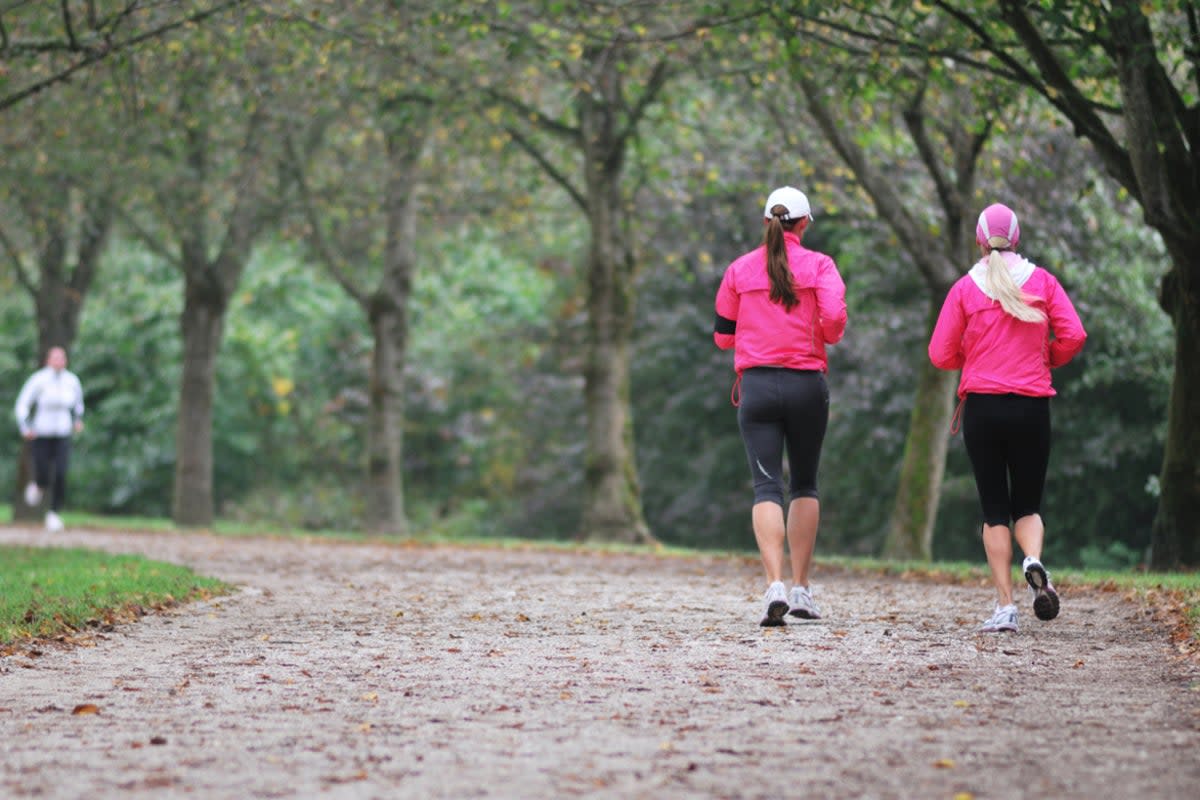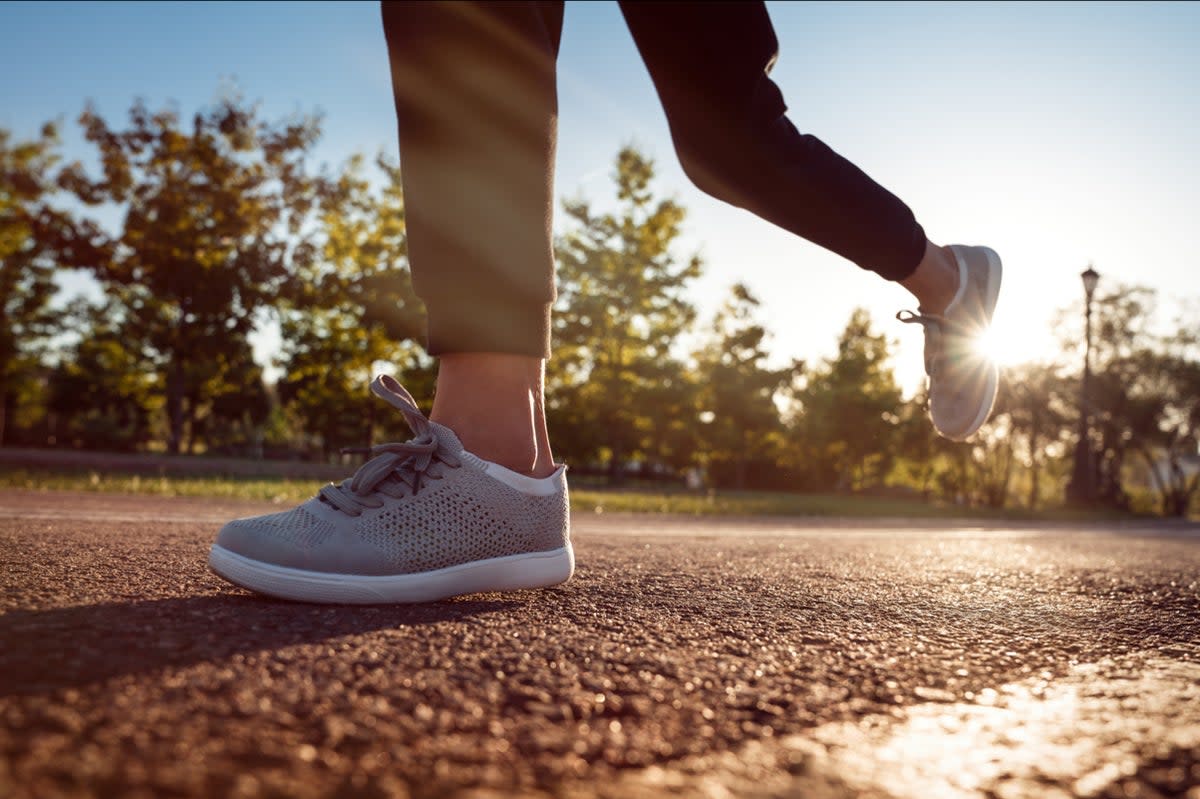I’m a slow runner – here’s how I found joy in plodding the pavements

Running can feel like a sport where timing is everything. Even amateurs get hooked on shaving seconds off their personal bests, humblebragging about their zippy pace on Strava and climbing up the ranks of their local Parkrun leaderboard. But what about those of us who just don’t seem to be built for speed?
I don’t run as much as plod. At Parkruns I’ve been overtaken by nine-year-olds and joggers pushing double-buggies. Last month I ran my first half marathon; I was the last of my friends to finish. But adopting a slower pace has been transformative. When I first started running during lockdown, I was manically sprinting as fast as possible (to get the whole ordeal over with as quickly as I could). As soon as the app on my phone told me that I’d hit 5km, I ground to a halt – plus, I seemed to be constantly jarring my already injury-prone knee. Now, though, I can go much further and, crucially, don’t actively despise every single minute of it.
And I’m not the only one trying to embrace life in the slow lane. On Instagram and TikTok, you’ll find a growing community of slow runners challenging the assumption that running has to be all about the pace. Of course “slow” is very subjective – and one self-identified slow runner’s easy speed might be another’s maximum exertion. Running experts tend to define it as a pace you could happily maintain while having a chat. “I don’t think that ‘slow’ should be a negative word,” says Emily Shane. She has clocked up more than 100,000 Instagram followers since she started documenting her marathon training online last year on her account @runswithemily. She’d previously had an “on-off relationship” with the sport until last year, when she decided to sign up for the 2024 Brighton Marathon. “I knew that I could enjoy running, but I was too caught up in the pace side of things, feeling like I needed to run really quick to be able to be ‘a runner,’” she says. Dialling down her speed “was hard initially, because you’re basically doing everything the opposite way to what you think you should be doing”, but soon “it felt more natural to do every time I went out”.
Many of her posts are dedicated to dismantling the idea that only certain types of runners (the ones who could smash a 5km in 20 minutes without breaking a sweat, for example) are “real” runners. “We see so much online from elite runners, super-fast runners and influencers whose whole lives are about going to the gym,” she says. “Running is a job that they’ve got time to dedicate to and improve. What I’m putting out there is what I wish I’d seen when I was training for the first time.” Inevitably, she receives the odd unsolicited critique – “like, ‘oh, you’re just not trying hard enough’ or ‘do you do any speed work?’, questioning my training” – but for the most part, the response has been “really positive. It’s given other people who are running at a similar pace to me a bit of acknowledgement.”
Twenty-six-year-old Celina Stephenson is another first-time marathoner who has been sharing her slow runs on social media. Her running journey didn’t have the most auspicious start, she admits. “When I was in school, I hated running,” she says. “I really got to a point where I thought there was something wrong with me, because everyone else could do at least a kilometre, whereas I was running 100 metres, gasping for air.” A few years later, she started training at the gym; her coach encouraged her to run short distances, which she did, under duress. “So it sounds a bit crazy, but one morning when I was fed up, I signed up for the London Marathon.” Not the most obvious move for a struggling runner, you might think. But her decision completely changed her relationship to the sport. “[My pace] used to be very, very very slow, where I was basically walking to get through the distance,” she adds. “I think it’s the best way to get your mind used to the idea of running: it covers the mileage and then you can speed up as you go.”
Once she started posting online about her marathon preparation, messages from other slower runners began to flood in; many of them suggested meeting up to train together. So she decided to organise a group run in Battersea Park (she’s based in Dublin, but her boyfriend lives in London, so she regularly travels back and forth between the two cities). Beforehand, she was so nervous that she ended up crying on the way there, but 50 people turned up for the first Runners High Run Club meet. Now the club convenes once a month to run 5km in different parks around London; about 200 people have turned up for the last couple of events.
The fastest pace, Stephenson says, tends to be around seven minutes per kilometre, and there’s always a pacer at the back of the group to make sure no one is left behind. In April, she held her first Runners High event in Dublin; 200 people have already bagged tickets for the next one, and there are a few hundred more people on the waitlist. “The thing with running clubs is it’s already scary to put yourself out there and go alone,” she says. “So to have the added layer of ‘I’m going to be left behind if I go…’ It is such a barrier to entry. My club gets rid of that: it’s just a place where people know they’ll be accepted and included.”

Adopting a leisurely pace can be good for injury-prone people like me, because it helps to “minimise repeated high-energy force on the skeletal system, muscular system, tendons and ligaments”, explains physiotherapist and Nike running coach Manni Ovola. Beyond that, he says, it can “build your cell function, especially in the mitochondria”, the part of our cells that generates energy. It also helps muscle function, “aiding in the quicker delivery of fuel to the right places” and building strength. And even if you’re naturally swift, many coaches now advocate the 80/20 rule for runners: completing about 80 per cent of your training at a lower intensity, with the remaining 20 per cent dedicated to speed work. “Validating each run with an improvement [in pace] is the most tempting approach for most runners,” Ovola notes. “You get a sense of progress, but you are straining and not training.”
When we focus on pace, we are discrediting our efforts: our time, our hard work and determination
Tanya Chouhan, @slowerunningmummy
The mental benefits can be just as important, too. There’s something quite clarifying about allowing yourself to move slowly after spending a frantic working day on autopilot, or working through your jumbled thoughts in the fresh air. Tanya Chouhan, who posts on the Instagram account @slowerunningmummy, found herself drawn to slow running while recovering from two miscarriages. “I was with my toddler and I couldn’t be sad, I could not really display those emotions,” she says. “So running was my time to process the loss … It’s definitely a personal journey, more than fitness [related]. I didn’t want to lose weight, I just wanted to run.”
Chouhan started her Instagram account last July because she’d been feeling insecure when she attended races, “because I started at the back of the pen” and wanted to reach “people out there who look like me, who run like me, and feel like me”; now she receives messages from followers every day, telling her she’s “inspired them to put their shoes on and just plod along”. Her philosophy is that “when we focus on pace, we are discrediting our efforts: our time, our hard work and determination, our grit, all of those good things.” And she believes that “we have enough stressors in our life, so running as a hobby shouldn’t be stressful as well”. In other words, we spend so much time trying to be perfect in all aspects of our life, and often end up applying that same approach to our free time. “If we keep harassing ourselves, even during our hobby, then what’s the point?” she asks. I couldn’t agree more – and I’ll ask myself the same thing the next time I’m feeling self-conscious about my tortoise-worthy pace.
